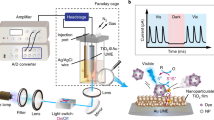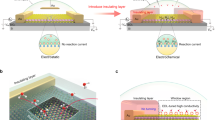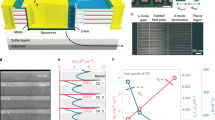Abstract
Photoelectrochemistry1,2,3 is one of several promising approaches4,5 for the realization of efficient solar-to-fuel conversion. Recent work has shown that photoelectrodes made of semiconductor nano-/microwire arrays can have better photoelectrochemical performance6,7,8 than their planar counterparts because of their unique properties, such as high surface area9,10,11. Although considerable research effort has focused on studying wire arrays, the inhomogeneity in the geometry, doping, defects and catalyst loading present in such arrays can obscure the link between these properties and the photoelectrochemical performance of the wires, and correlating performance with the specific properties of individual wires is difficult because of ensemble averaging. Here, we show that a single-nanowire-based photoelectrode platform can be used to reliably probe the current–voltage (I–V) characteristics of individual nanowires. We find that the photovoltage output of ensemble array samples can be limited by poorly performing individual wires, which highlights the importance of improving nanowire homogeneity within an array. Furthermore, the platform allows the flux of photogenerated electrons to be quantified as a function of the lengths and diameters of individual nanowires, and we find that the flux over the entire nanowire surface (7–30 electrons nm–2 s–1) is significantly reduced as compared with that of a planar analogue (∼1,200 electrons nm–2 s–1). Such characterization of the photogenerated carrier flux at the semiconductor/electrolyte interface is essential for designing nanowire photoelectrodes that match the activity of their loaded electrocatalysts.
This is a preview of subscription content, access via your institution
Access options
Subscribe to this journal
Receive 12 print issues and online access
$259.00 per year
only $21.58 per issue
Buy this article
- Purchase on Springer Link
- Instant access to full article PDF
Prices may be subject to local taxes which are calculated during checkout




Similar content being viewed by others
References
Bard, A. J. Photoelectrochemistry. Science 207, 139–144 (1980).
Grätzel, M. Photoelectrochemical cells. Nature 414, 338–344 (2001).
Walter, M. G. et al. Solar water splitting cells. Chem. Rev. 110, 6446–6473 (2010).
Reece, S. Y. et al. Wireless solar water splitting using silicon-based semiconductors and earth-abundant catalysts. Science 334, 645–648 (2011).
Wang, H. et al. Semiconductor heterojunction photocatalysts: design, construction, and photocatalytic performances. Chem. Soc. Rev. 43, 5234–5244 (2014).
Hwang, Y. J., Boukai, A. & Yang, P. High density n-Si/n-TiO2 core/shell nanowire arrays with enhanced photoactivity. Nano Lett. 9, 410–415 (2009).
Hwang, Y. J., Wu, C. H., Hahn, C., Jeong, H. E. & Yang, P. Si/InGaN core/shell hierarchical nanowire arrays and their photoelectrochemical properties. Nano Lett. 12, 1678–1682 (2012).
Liu, R. et al. Silicon nanowires as photoelectrodes for carbon dioxide fixation. Angew. Chem. Int. Ed. 51, 6709–6712 (2012).
Mayer, M. T., Lin, Y., Yuan, G. & Wang, D. Forming heterojunctions at the nanoscale for improved photoelectrochemical water splitting by semiconductor materials: case studies on hematite. Acc. Chem. Res. 46, 1558–1566 (2013).
Wu, Y., Yan, H. & Yang, P. Semiconductor nanowire array: potential substrates for photocatalysis and photovoltaics. Top. Catal. 19, 197–202 (2002).
Liu, C., Dasgupta, N. P. & Yang, P. Semiconductor nanowires for artificial photosynthesis. Chem. Mater. 26, 415–422 (2014).
Cui, Y., Wei, Q., Park, H. & Lieber, C. M. Nanowire nanosensors for highly sensitive and selective detection of biological and chemical species. Science 293, 1289–1292 (2001).
Yan, R. et al. Nanowire-based single-cell endoscopy. Nature Nanotech. 7, 191–196 (2012).
Tian, B., Kempa, T. J. & Lieber, C. M. Single nanowire photovoltaics. Chem. Soc. Rev. 38, 16–24 (2009).
Tang, J., Huo, Z., Brittman, S., Gao, H. & Yang, P. Solution-processed core–shell nanowires for efficient photovoltaic cells. Nature Nanotech. 6, 568–572 (2011).
Hochbaum, A. I. et al. Enhanced thermoelectric performance of rough silicon nanowires. Nature 451, 163–167 (2008).
Cox, J. T. & Zhang, B. Nanoelectrodes: recent advances and new directions. Annu. Rev. Anal. Chem. 5, 253–272 (2012).
Boettcher, S. W. et al. Photoelectrochemical hydrogen evolution using Si microwire arrays. J. Am. Chem. Soc. 133, 1216–1219 (2011).
Hou, Y. et al. Bioinspired molecular co-catalysts bonded to a silicon photocathode for solar hydrogen evolution. Nature Mater. 10, 434–438 (2011).
Esposito, D. V., Levin, I., Moffat, T. P. & Talin, A. A. H2 evolution at Si-based metal–insulator–semiconductor photoelectrodes enhanced by inversion channel charge collection and H spillover. Nature Mater. 12, 562–568 (2013).
Ji, L. et al. A silicon-based photocathode for water reduction with an epitaxial SrTiO3 protection layer and a nanostructured catalyst. Nature Nanotech. 10, 84–90 (2015).
Gorostiza, P., Allongue, P., Díaz, R., Morante, J. R. & Sanz, F. Electrochemical characterization of the open-circuit deposition of platinum on silicon from fluoride solutions. J. Phys. Chem. B 107, 6454–6461 (2003).
Hochbaum, A. I., Fan, R., He, R. & Yang, P. Controlled growth of Si nanowire arrays for device integration. Nano Lett. 5, 457–460 (2005).
Allen, J. E. et al. High-resolution detection of Au catalyst atoms in Si nanowires. Nature Nanotech. 3, 168–173 (2008).
Koren, E. et al. Direct measurement of individual deep traps in single silicon nanowires. Nano Lett. 11, 2499–2502 (2011).
Barton, E. E., Rampulla, D. M. & Bocarsly, A. B. Selective solar-driven reduction of CO2 to methanol using a catalyzed p-GaP based photoelectrochemical cell. J. Am. Chem. Soc. 130, 6342–6344 (2008).
Kumar, B., Smieja, J. M. & Kubiak, C. P. Photoreduction of CO2 on p-type silicon using Re(bipy-But)(CO)3Cl: photovoltages exceeding 600 mV for the selective reduction of CO2 to CO. J. Phys. Chem. C 114, 14220–14223 (2010).
Benson, E. E., Kubiak, C. P., Sathrum, A. J. & Smieja, J. M. Electrocatalytic and homogeneous approaches to conversion of CO2 to liquid fuels. Chem. Soc. Rev. 38, 89–99 (2009).
Appel, A. M. et al. Frontiers, opportunities, and challenges in biochemical and chemical catalysis of CO2 fixation. Chem. Rev. 113, 6621–6658 (2013).
Hori, Y. et al. Electrocatalytic process of CO selectivity in electrochemical reduction of CO2 at metal electrodes in aqueous media. Electrochim. Acta 39, 1833–1839 (1994).
Acknowledgements
This work was supported by the Director, Office of Science, Office of Basic Energy Sciences, Materials Sciences and Engineering Division, of the US Department of Energy (contract no. DE-AC02-05CH11231, Pchem). Y.S. is supported by graduate fellowship support from USTC-Suzhou Industrial Park. High-resolution transmission electron microscopy was performed at the National Center of Electron Microscopy (NCEM) in the Molecular Foundry at Lawrence Berkeley National Laboratory. The authors thank K. Sakimoto, J. Resasco, A. Wong, S. Eaton and J. Lim for discussions. The authors acknowledge the Marvell Nanofabrication Laboratory for use of their facilities.
Author information
Authors and Affiliations
Contributions
Y.S., C.L. and P.Y. conceived and designed the experiments. Y.S., C.L., S.B. and J.T. fabricated the single-nanowire devices. Y.S. and C.L. performed the PEC measurements on single-nanowire devices. Y.S., C.L. and A.F. carried out the numerical calculation. Y.S. and Q.K. fabricated and characterized the nanowire array samples. N.K. carried out the high-resolution TEM imaging. Y.S., C.L. and P.Y. co-wrote the paper. All authors discussed the results and revised the manuscript.
Corresponding author
Ethics declarations
Competing interests
The authors declare no competing financial interests.
Supplementary information
Supplementary information
Supplementary information (PDF 2199 kb)
Rights and permissions
About this article
Cite this article
Su, Y., Liu, C., Brittman, S. et al. Single-nanowire photoelectrochemistry. Nature Nanotech 11, 609–612 (2016). https://doi.org/10.1038/nnano.2016.30
Received:
Accepted:
Published:
Issue Date:
DOI: https://doi.org/10.1038/nnano.2016.30
This article is cited by
-
Water splitting with silicon p–i–n superlattices suspended in solution
Nature (2023)
-
Recent Advancements in Photoelectrochemical Water Splitting for Hydrogen Production
Electrochemical Energy Reviews (2023)
-
Photo-assisted decoration of Ag-Pt nanoparticles on Si photocathodes for reducing overpotential toward enhanced photoelectrochemical water splitting
Science China Materials (2022)
-
Photoluminescence and Boosting Electron–Phonon Coupling in CdS Nanowires with Variable Sn(IV) Dopant Concentration
Nanoscale Research Letters (2021)
-
Faceting of Si and Ge crystals grown on deeply patterned Si substrates in the kinetic regime: phase-field modelling and experiments
Scientific Reports (2021)



